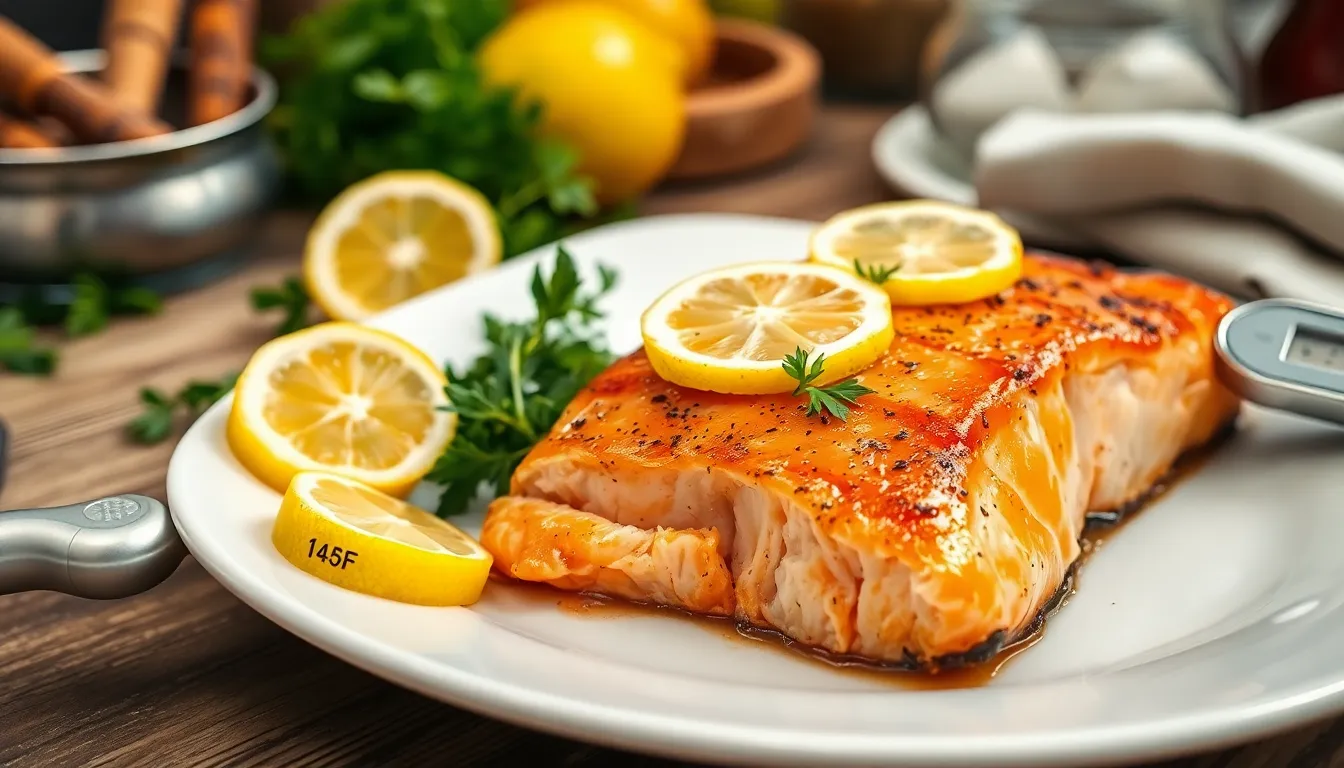Cooking salmon can feel like a culinary mystery wrapped in a fishy enigma. With so many methods and temperatures to choose from, it’s easy to get lost in the sea of options. But fear not! Whether you’re aiming for that perfectly flaky texture or a crispy skin that could rival a potato chip, knowing what temperature to cook salmon at is the secret sauce to your success.
Table of Contents
ToggleUnderstanding Salmon Cooking Techniques
Cooking salmon accurately requires knowledge of various techniques. Each method brings out distinct flavors and textures that make salmon enjoyable.
Baking
Baking salmon involves cooking it in an oven, typically set between 350°F and 450°F. Cooking times range from 12 to 20 minutes, depending on thickness. A general rule suggests 4 to 6 ounces of salmon should bake for about 15 minutes per inch of thickness. For an appealing taste, seasoning with herbs, lemon, or garlic enhances the flavor profile.
Grilling
Grilling salmon presents an opportunity for delicious char and smokiness. Preheating the grill to medium-high heat, around 375°F to 450°F, creates a perfect environment. Cooking time generally spans 6 to 8 minutes per side. Oil and seasoning help prevent sticking while ensuring the salmon retains moisture.
Pan-Searing
Pan-searing provides a crispy skin and moist interior. Using a skillet, heat to medium-high, with temperatures between 375°F and 400°F. Cooking times often range from 3 to 5 minutes per side. Skin-on fillets yield the best results, and adding a touch of butter or oil enhances the richness.
Ideal Temperatures for Cooking Salmon

Cooking salmon at the right temperature ensures optimal flavor and texture. Knowing the ideal temperature ranges plays a key role in the cooking process.
Temperature Ranges
Salmon cooks well within specific temperature ranges. Baking typically occurs between 350°F and 450°F for 12 to 20 minutes. Grilling requires a medium-high heat, around 375°F to 400°F. For grilling, 6 to 8 minutes per side often yields the best results. Pan-searing prefers medium-high heat, accomplishing perfect crispiness in 3 to 5 minutes per side. The recommended internal temperature for salmon is 145°F, guaranteeing both safety and quality.
| Cooking Method | Temperature Range (°F) | Cooking Time |
|---|---|---|
| Baking | 350 – 450 | 12 – 20 minutes |
| Grilling | 375 – 400 | 6 – 8 minutes per side |
| Pan-Searing | Medium-high | 3 – 5 minutes per side |
Using a Meat Thermometer
A meat thermometer ensures accuracy when cooking salmon. Inserting it into the thickest part of the fillet provides clear temperature readings. Checking for an internal temperature of 145°F confirms that the salmon is fully cooked. Some cooks prefer temperatures of 125°F to 135°F for a softer, medium-rare texture. Using a digital meat thermometer makes monitoring easy and minimizes guesswork. Under-cooked salmon increases the risk of foodborne illness, while overcooked salmon can lead to dryness, so precision is vital.
Flavorful Marinades and Seasonings
Marinades and seasonings elevate salmon’s flavors. Using them enhances texture and taste effectively.
Herbs and Spices
Fresh herbs like dill, parsley, and cilantro pair well with salmon. Dried spices such as paprika, cumin, and garlic powder also offer robust flavors. Choosing herbs that complement salmon’s natural taste is essential. Basil and thyme bring a delightful aroma. Experimenting with different combinations can create unique flavor profiles. Ensure to apply the herbs and spices generously before cooking to maximize infusion.
Citrus and Acidity
Citrus fruits add brightness to salmon dishes. Lemons, limes, and oranges enhance flavor with their acidity. A splash of lemon juice can balance richness effectively. Marinating salmon in citrus juice for 30 minutes infuses it with tangy notes. Vinegars, such as balsamic or apple cider, also contribute a pleasant acidity. Combining citrus with herbs can create a refreshing marinade that complements grilled or baked salmon beautifully.
Cooking Times Based on Thickness
Cooking times for salmon vary depending on the thickness of the cut. Understanding differences between fillets, steaks, and whole salmon ensures optimal results.
Fillets vs. Steaks
Fillets cook faster than steaks due to their thinner profile. Typical cooking time for a 1-inch thick fillet ranges from 10 to 12 minutes, whether baking or grilling. Steaks, generally about 1 to 1.5 inches thick, require 12 to 15 minutes for similar methods. Monitoring the internal temperature remains crucial; fillets and steaks should reach 145°F for safety. Adjustments in time may apply based on preferred doneness levels. For extra flavor, seasoning or marinating enhances both cuts.
Whole Salmon
Whole salmon takes more time to cook than individual fillets or steaks. For a 3 to 4-pound whole salmon, baking or roasting at 375°F requires approximately 20 to 25 minutes. A thicker fish ensures even cooking, reaching that ideal internal temperature. When cooking whole salmon, placing citrus slices inside can infuse delightful flavor. Always use a meat thermometer for the most accurate results and check the thickest part for doneness. Allowing a few minutes to rest before serving enhances the texture and taste further.
Cooking salmon doesn’t have to be daunting. By understanding the right temperatures and techniques, anyone can achieve a delicious result. Whether opting for baking grilling or pan-searing the key is to monitor the internal temperature. A perfectly cooked salmon at 145°F ensures both safety and optimal flavor.
Experimenting with marinades and seasonings can elevate the dish further. Fresh herbs and citrus not only enhance taste but also add a refreshing twist. With a bit of practice and attention to detail anyone can master the art of cooking salmon and enjoy its rich flavors and health benefits.










